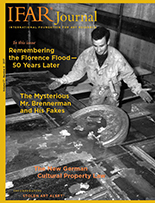 IFAR Journal
IFAR Journal
Archives contain primary sources such as letters, records, and other documents, organized into collections, that can be navigated by finding aids. The archival collections of galleries and museums are often essential to provenance research. You may need to first figure out which archive may have collections relevant to your search.
From the French word provenir, which means "to come from," provenance is the history of ownership of a valued object, such as a work of art
Why do we conduct provenance research?
Where do you find provenance?
Provenance research is found in many different places. it is in many ways very different from other art history research. Resources such as dealer's records, collection inventories, military reports, legal proceedings, newspaper articles and museum records can be useful for establishing provenance.
Catalogues Raisonnes are vital sources for research provenance and for identifying works of art. The CU Boulder library has an extensive collection, try searching for artists plus "catalogue raisonne" or "complete works". However, since these are expensive and sometime produced in limited quantities there will be some that we don't have, for those you can search the IFAR database, and request items through Worldcat and interlibrary loan.
Most comprehensive database of worldwide library holdings. Limited to 40 simultaneous users across the state of Colorado.
